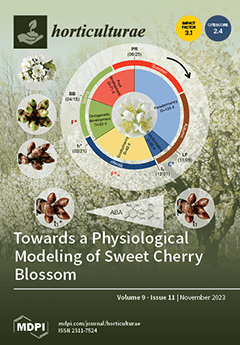Potassium is one of the indispensable nutrient elements for plant growth, fruit development, and yield. The research and application of potassium nutrition diagnosis technology is the premise of scientific potassium management. However, potassium deficiency in tomato leaves, from vegetative to reproductive growth, is
[...] Read more.
Potassium is one of the indispensable nutrient elements for plant growth, fruit development, and yield. The research and application of potassium nutrition diagnosis technology is the premise of scientific potassium management. However, potassium deficiency in tomato leaves, from vegetative to reproductive growth, is not easy to diagnose. To alleviate this problem, this paper proposes a suitable method of supplying potassium to tomatoes via a nutrient solution and diagnosing potassium abundance and deficiency through diagnosis methods based on ecological morphology, biological accumulation, and the photosynthetic characteristics of tomato plants. The relationship between the ecological morphology and biomass accumulation of tomatoes cultivated in the nutrient solution with potassium supply levels of 1, 4, 8, and 16 mmol/L is also discussed, and the potassium supply in the nutrient solution was studied 21 days after transplanting. The results showed that there was a significant quadratic correlation between the potassium supply in the nutrient solution and plant height and biomass accumulation, respectively. The most suitable level of potassium supply via the nutrient solution was deemed to be 10~13 mmol/L. However, if irreversible damage or severe stress to tomato plants has occurred because of potassium deficiency, there will be serious differences in the growth status of plants, and the diagnosis results will deviate greatly. In addition, the photosynthetic induction characteristics responding to the dark–light conversion of tomato leaves with potassium contents of 0.9%, 2.1%, 3.1%, and 3.3% cultivated with potassium supply amounts of 1, 4, 8, and 16 mmol/L in the nutrient solution were investigated. The results showed that tomato leaves with potassium contents of 3.1% and 3.3% had a more rapid response to dark–light conversion and higher first-order derivatives of net photosynthetic rate compared to those with potassium contents of 0.9% and 2.1%, but the first-order derivative of intercellular CO
2 concentration showed an opposite trend. Additionally, a quadratic correlation between leaf potassium content and CO
2 assimilation during 5 min of photosynthetic induction was established (R
2 > 0.99). According to this correlation, the suitable leaf potassium content was estimated to be 2.3~2.7%, similar to that of tomatoes cultured in the nutrient solution with a 4~8 mmol/L potassium supply. Therefore, this method can realize the rapid, non-destructive, and real-time detection of potassium content in tomato leaves based on a portable photosynthetic measurement system by establishing the relationship between leaf potassium content and net CO
2 assimilation during the photosynthetic induction period, therefore helping to avoid the irreversible damage caused by potassium deficiency at the later stages of plant cultivation and providing technical support for the precise fertilization of potassium in actual cultivation.
Full article





